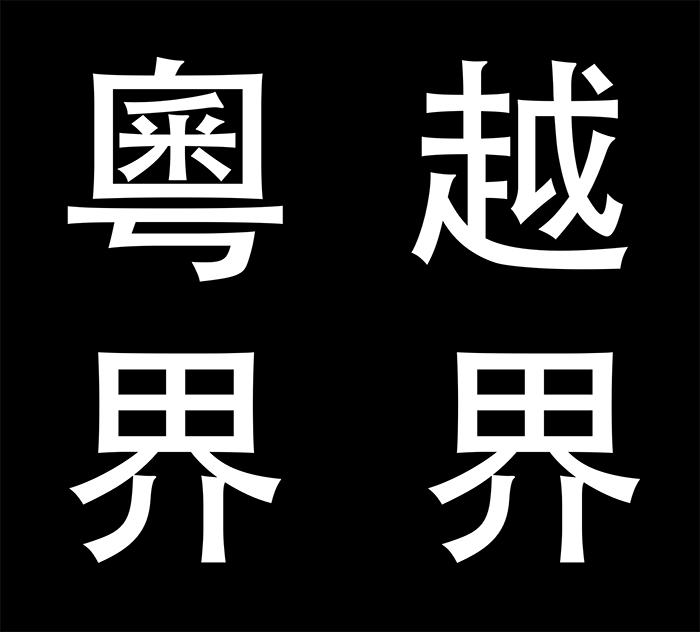越界/粵界(TRANSGRESSION/CANTOSPHERE)
Hong Kong Exile
in collaboration with Zoe Lam and Howie Tsui
January 22 – March 28, 2015
Opening reception: Thursday, January 22 | 7pm
Gallery Hours: Tuesday-Saturday, 11am – 6pm
As part of a long effort to standardize language throughout China, in 2012, at the behest of authorities in Beijing, and to uproar throughout the Canto-sphere, the Guangdong local government enacted the Guangdong National Language Regulations: a set of regulations that squeezes Cantonese language off of the airwaves and removes it from use in the public sector including government offices and schools. Even autonomous Hong Kong is facing pressures from these homogenizing forces.
Here in Vancouver, ominous signs of Mandarinisation have hovered over Chinatown in recent years. In one example, due either to ignorance of local circumstances or an intention to appeal to Mainland Chinese buyers, Westgroup, the developer of a condo at the South West corner of Keefer and Main, greeted Canada’s foremost Cantonese and other Yuht (粵) language speaking neighbourhood with a massive “NI HAO”. “Hello” in the main languages of Chinatown is not “Ni hao,” rather, it is “Nei hou” and “Lei hou”, depending on dialect. For locals, Westgroup’s sign was a reminder of broader forces of cultural loss.
When space for and means of cultural expression and autonomy are attacked, people react. In Hong Kong, 2014’s Occupy Central protests had to do with far more than systems of government. It was also a reaction to growing anxiety over loss of culture. During the protests, Cantonese speakers and supporters here in Vancouver and around the world flooded their Facebook feeds with re-coloured Hong Kong flags, yellow umbrellas on black backgrounds, and other expressions of resistance, resilience and solidarity.
What more could those abroad do? The capacity of Cantonese culture to articulate itself in its own language has been under consistent attack. If urban space for Cantonese language and culture are under threat in Hong Kong and Guangdong Province, what of Chinatown? Is Vancouver indifferent? Does the city play impotent to market forces? How serious can this community be about preserving intangible cultural heritage? Is it imaginable or appropriate to imagine that Vancouver’s Chinatown could one day be protected as a hub of 粵 cultural vitality? Maybe not.
In the film Everything Will Be…, Julia Kwan’s melancholic portrait of an aging Chinatown in decline, real estate marketer Bob Rennie asserts that the future of Chinatown will be more “multicultural,” while simultaneously being portrayed as engaging in the museafication of the neighbourhood’s heritage. The emergence of Euro-American galleries and businesses over the last few years along with condos marketed to a predominantly white creative class attest to the impending displacement of Canada’s most deeply rooted 粵-scape.
Academics state that without preventative action, we could see the near complete loss of Cantonese and other 粵 languages globally within a century. First they will disappear from use in the urban landscape, the airwaves and the cultural sphere. Soon after, if we aren’t careful, they will disappear from the home.
Cultural diversity in the anthroposphere is equivalent to biological diversity in the biosphere. We have to fight to ensure that there are habitats. Decades of urban planning ignorance, malice or failure in Vancouver have degraded the potential of linguistic and cultural vitality in Chinatown. And now, after a long season of depressed land values, the predictable players in Vancouver’s development game have stepped forward to make Chinatown, as Rennie puts it, “more multicultural.” The stage is set for cultural forces to execute the final push, ridding the city’s core of a sector of 粵 linguistic and cultural vitality. It appears that little care is being taken to ensure the vitality of the intangible cultural heritage that resides in the texture of everyday life in this neighbourhood.
In 越界/粵界(transgression/cantosphere), interdisciplinary art company Hong Kong Exile (Natalie Tin Yin Gan, Milton Lim, Remy Siu), in collaboration with linguist Zoe Lam and artist Howie Tsui, grapple with local and international pressures on their mother culture. The exhibit strikes back with a potent celebratory engagement with Cantonese language coupled with a reflection on the relationship between urban planning and the multiculturalisation of “Historic Chinatown.” A hopeful assertion of the value of diversity, 越界/粵界(transgression/cantosphere) challenges forces of homogenization and invites the public to consider what actions and invocations are called for in the quest for diverse cultural vitality in Vancouver’s urban core and around the world.
Hong Kong Exile (HKX) is a Vancouver-based interdisciplinary arts company comprising of three artists: Milton Lim (Theatre), Remy Siu (New Music), and Natalie Tin Yin Gan (Dance). The company’s work investigates cultural politics in an era of globalization and strives to unpack the complexities of the growing Asian diaspora. Since its inception in 2011, HKX has created more than twelve original productions and is currently presenting individual and company pieces across North America.
Born and raised in Hong Kong, Zoe Lam is a linguist currently pursuing her doctoral degree at University of British Columbia. Her research has been published in leading journals such as Studies in Chinese Linguistics and Journal of the Southeast Asian Linguistics Society. Being an art lover and social activist, she was invited by Centre A to be the Cantonese instructor in a community art project in Vancouver Chinatown, entitled M’goi/Do Jeh: Sites, Rites and Gratitude. Highlights of the class include flashcard drawing, dimsum tours and collaborative cooking. Concerned about the revitalization of the neighbourhood and the preservation of Cantonese culture, Zoe is an active member of the Chinatown community.
Vancouver-based artist Howie Tsui (Tsui Ho Yan / 徐浩恩) was born in Hong Kong and raised in Lagos, Nigeria and Thunder Bay. He holds a BFA (2002) in painting from the University of Waterloo and received the Joseph S. Stauffer Prize (2005) from the Canada Council for most outstanding young artist. His work is in the public collections of the National Gallery of Canada, Canada Council Art Bank, City of Ottawa, Ottawa Art Gallery and Centre d’exposition de Baie-Saint-Paul. Solo exhibitions include Gallery 101, Carleton University Art Gallery, AceArtInc (Winnipeg), Montréal arts interculturels, Centre A (Vancouver), Agnes Etherington Art Centre (Kingston), Art Gallery of Southwestern Manitoba, with group engagements at the West Vancouver Museum, Boston University School of Fine Arts and the Asian Art Museum of San Francisco.
PRESS COVERAGE
“《越界/粵界》展 保育粵語文化”, Ming Pao Canada, January 24, 2015.
“越界/粵界(transgression/cantosphere) @ Centre A”, Vandocument, January 28, 2015.
“Hong Kong Exile is Hot”, Tim Carlson, Theatre Conspiracy.
“Cantonese Indifference: The Language of Chinatown”, Irene Lo, Vandocument, January 31, 2015.
“New art exhibit transgression/cantosphere explores a language under threat”, Chloë Lai, The Ubyssey, February 5, 2015.
“3 Awesome Things to do in Chinatown after the Vancouver Chinese New Year Parade”, Megan Lau, Hua Foundation, February 17, 2015.
“Chinatown’s Last Stand”, Kelsey Klassen, The Westender, February 18, 2015.
“Vancouver’s Chinatown Faces Changes and Challenges”, Kelsey Klassen, Vancouver Courier, February 19, 2015.
“New Exhibit Provides Thought-Provoking Take on Cantonese Language”, Florence Hwang, The Source, Vol. 15 Issue 14, February 24 – March 10, 2015.










